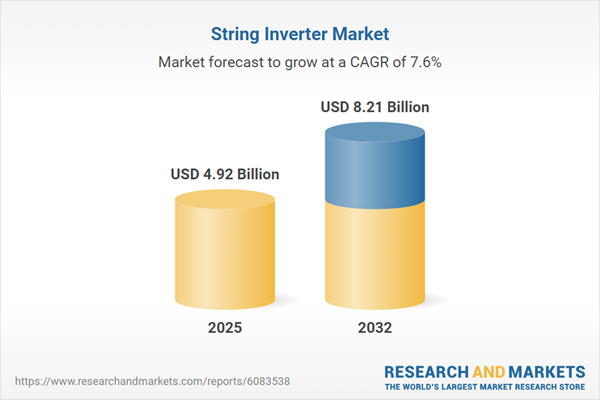Speak directly to the analyst to clarify any post sales queries you may have.
The String Inverter Market is evolving, driven by mounting demands for greater reliability, efficiency, and intelligent system integration within solar energy infrastructures. This report provides senior decision-makers with clarity on current market dynamics, emerging opportunities, and strategic imperatives shaping the global competitive landscape.
Market Snapshot: String Inverter Market Growth at a Glance
The string inverter market grew from USD 4.58 billion in 2024 to USD 4.92 billion in 2025 and is projected to reach USD 8.21 billion by 2032, achieving a CAGR of 7.55%. This upward trend reflects the industry’s rapid adoption of advanced power conversion solutions and the rising scale of solar installations in both established and emerging regions.
Scope & Segmentation of the String Inverter Market
This report comprehensively examines all critical dimensions influencing future growth:
- Phase Type: Single phase systems are prevalent in small-scale and residential settings, while three phase units are the preferred choice for larger commercial and industrial deployments requiring higher voltage performance.
- Power Rating: Diverse application needs are addressed with below 3 kW, 3 to 5 kW, below 5 kW, 5 to 7.5 kW, 7.5 to 10 kW, 5 to 10 kW, and above 10 kW inverter options, with tailored thermal management and operational characteristics.
- Monitoring Type: Inverter-level, module-level, and string-level monitoring platforms deliver varying degrees of performance visualization, catering to differing asset management requirements.
- Cooling Method: Convection and fan-cooled inverters are offered to balance installation density, ambient conditions, and system longevity.
- End Use: Configurations serve the commercial, industrial, and residential segments, each requiring particular design, integration, and reliability features.
- Application: Off-grid systems emphasize autonomy and battery management, while on-grid setups prioritize synchronization and grid support capabilities.
- Regional Coverage: In-depth analysis spans North America (United States, Canada, Mexico), Latin America (Brazil, Argentina, Chile, Colombia, Peru), Europe (United Kingdom, Germany, France, Russia, Italy, Spain, Netherlands, Sweden, Poland, Switzerland), Middle East (UAE, Saudi Arabia, Qatar, Turkey, Israel), Africa (South Africa, Nigeria, Egypt, Kenya), and Asia-Pacific (China, India, Japan, Australia, South Korea, Indonesia, Thailand, Malaysia, Singapore, Taiwan).
- Leading Manufacturers: Detailed insights include Sungrow Power Supply Co., Ltd., Huawei Digital Power Technologies Co., Ltd., SolarEdge Technologies, Inc., SMA Solar Technology AG, Growatt New Energy Technology Co., Ltd., TBEA Shandong Sunoasis Co., Ltd., Schneider Electric SE, Fronius International GmbH, Delta Electronics, Inc., and Jiangsu GoodWe Power Supply Technology Co., Ltd.
Key Takeaways for Senior Decision-Makers
- Technological advancements, notably the integration of wide-bandgap semiconductors and smart monitoring, are enabling higher operational efficiency and reduced maintenance requirements.
- Distributed inverter architectures now dominate, minimizing single-point failures and simplifying grid integration across complex installations.
- Manufacturers are responding to regional policy changes by localizing supply chains, establishing assembly hubs, and forming collaborations with regional system integrators.
- Grid support capabilities—including real-time performance optimization, reactive power management, and ride-through functions—position inverters as critical grid assets rather than passive converters.
- Customer acquisition strategies increasingly depend on modular product portfolios, digital service integration, and sustainability initiatives to meet the evolving demands of large solar portfolios and ESG-focused buyers.
Tariff Impact: Navigating 2025 Policy Changes
Pending United States tariffs in 2025 are prompting global inverter suppliers to reassess production locations and supply base strategies. Leading manufacturers are pursuing investments in regional assembly and supply partnerships to reduce tariff exposure. Contract terms with EPCs and end users now emphasize risk allocation, with transparent tariff pass-through mechanisms and force majeure clauses gaining prominence. These policy developments are influencing vendor selection and contract duration across the value chain.
Methodology & Data Sources
This analysis is underpinned by a robust research approach, combining primary interviews with system integrators, developers, utilities, and regulatory agencies, as well as secondary research from industry reports, technical documents, and proprietary data sets. Data validation techniques—including cross-checking across multiple sources and peer-reviewed audits—ensure actionable and objective market insights.
Why This Report Matters
- Delivers strategic intelligence for C-level leaders to prioritize technology investments and anticipate regulatory impacts.
- Equips organizations to optimize supply chain resilience, adapt product strategies, and strengthen market positioning.
- Enables informed decisions with granular segmentation, competitive benchmarking, and coverage of emerging trends in the string inverter market.
Conclusion
The string inverter market is advancing as a result of innovation, changing regulatory scenarios, and expanding regional adoption. Forward-looking organizations can leverage this intelligence to maximize value from next-generation inverter solutions and build competitive advantage in a dynamic energy landscape.
Table of Contents
3. Executive Summary
4. Market Overview
7. Cumulative Impact of Artificial Intelligence 2025
Companies Mentioned
The companies profiled in this String Inverter market report include:- Sungrow Power Supply Co., Ltd.
- Huawei Digital Power Technologies Co., Ltd.
- SolarEdge Technologies, Inc.
- SMA Solar Technology AG
- Growatt New Energy Technology Co., Ltd.
- TBEA Shandong Sunoasis Co., Ltd.
- Schneider Electric SE
- Fronius International GmbH
- Delta Electronics, Inc.
- Jiangsu GoodWe Power Supply Technology Co., Ltd.
Table Information
| Report Attribute | Details |
|---|---|
| No. of Pages | 190 |
| Published | October 2025 |
| Forecast Period | 2025 - 2032 |
| Estimated Market Value ( USD | $ 4.92 Billion |
| Forecasted Market Value ( USD | $ 8.21 Billion |
| Compound Annual Growth Rate | 7.5% |
| Regions Covered | Global |
| No. of Companies Mentioned | 11 |









